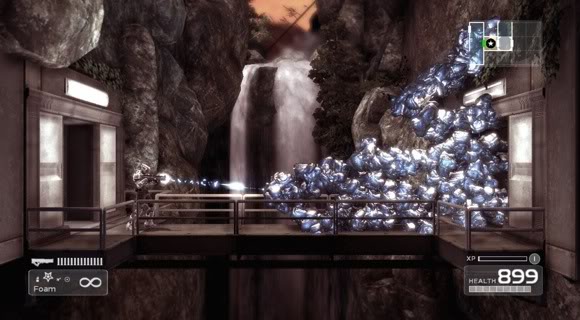Editor's note: I am still on the road post-Gamescom, so I haven't had a chance to play Shadow Complex yet — and it's killing me. Reading Jon's post about how developer Chair has successfully evolved the Metroidvania genre makes the wait even harder! -Demian
Shadow Complex has easily become one of the most critically acclaimed titles to hit Xbox Live Marketplace — it evokes our nostalgia for classic games like Super Metroid and Castlevania: Symphony of the Night, while updating the foundations of those titles with modern gameplay mechanics.
While some die-hards feel Shadow Complex isn't quite as good as what it emulates, I disagree; the game does a lot of interesting things to evolve the 'Metroidvania' genre, and ultimately is more mature than the games of our memories. I've outlined some of those advancements below….

Environmental Obstacles That Make Sense
One element of Super Metroid that bothers me to this day is the fact that somehow a red door is significantly more durable than a blue door, and a green door is kind of a big deal. Some floors or thin walls are impervious to super missiles, but incredibly vulnerable to supersonic sprinting.
Shadow Complex contextualizes these disjointed obstacles into believable elements of an industrial facility. A pile of large stones may not be dislodged by a series of grenades, but a missile would certainly pack the punch to knock down this natural barrier. A blast door is obviously a bit sturdier than a simple air vent cover. This simple, logical use of environmental elements makes Shadow Complex’s world more believable on a fundamental level.
Flexible Platforming, Speedier Progress
With incredibly large maps and plenty of different zones to explore, games in the Metroidvania side-scrolling action genre can sometimes be a pain to navigate. Shadow Complex's basic tools include a particular useful and unique weapon called the foam gun, which allows you to construct footholds and bridges, and in classic Metroid fashion, double jumps and even triple jumps allow Jason to reach high platforms.
In addition, the final act of the game introduces a weapon that’s almost purely for utility, the hookshot. All of these options not only make it possible to reach the highest points on the map, but allow for different methods of overcoming a particular platforming section and much faster navigation.
Rewarding Completionists, and Encouraging Multiple Playthroughs
Each of the games in Shadow Complex’s subgenre tend to have RPG elements that reward players for exploration with upgrades to their arsenal, but these upgrades are not always worth the effort.
While each missile capacity upgrade gave you five more shots to take on Ridley in Super Metroid, in the end you could still mess up if you lack the proper timing. Shadow Complex opts for a different approach, empowering the most ambitious of collectors by rewarding them with infinite ammunition for weapons they’ve completely upgraded.
Not only that, but various armor upgrades acquired throughout the course of the game can give you more maneuverability or make you practically invulnerable. By investing your time in fully exploring the complex, Jason can be an unstoppable tool of destruction, providing the player with a great sense of superiority.

In concert, all of these innovative techniques make Shadow Complex both friendly and satisfying.
The last 2D Metroid games were Metroid: Zero Mission and Metroid Fusion, both of which played it safe by adding only a couple of new weapons to Samus’s arsenal, and took place in somewhat predictable environments. If Nintendo hears the call of its customers and decides to make a more traditional Metroid follow-up, I hope they take notice of some of the innovations that Shadow Complex brought to the table and present us with a further-evolved vision of this subgenre.



